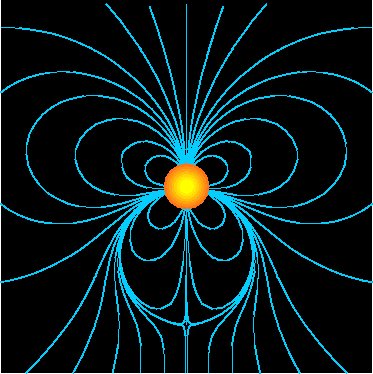
A complex magnetic field structure appears to be the explanation for unusual circular polarization properties in active stars, as Michelle Storey and Jenny Nicholls have found out.
Active stars produce bursts of emission at radio, optical and X-ray frequencies that are tens of thousands of times more intense than the bursts observed on the Sun. In between flares many active stars produce observable quiescent radio emission, called gyrosynchrotron emission, from energetic electrons spiraling in the magnetic field of the star. Observations suggest that the quiescent emission is associated with large-scale magnetic structures that don't change greatly with time.
Observations also show that the radio emission is partially circularly polarized, a property of gyrosynchrotron and other types of emission. Whilst simple models of the gyrosynchrotron emission can reproduce the intensity of emission at different frequencies reasonably well, the models do not match the observed circular polarization: the maximum percentage circular polarization of the models occurs at frequencies much lower than is observed. Most models to date assume simple magnetic field morphologies, whereas the real magnetic field structures in these systems are likely to be complex. Calculations incorporating two separate emission regions have been more successful in explaining the observations, but no consistent model of the emission region incorporating two regions has been developed before now.
Michelle Storey and Jenny Nicholls have produced a three-dimensional numerical model for these systems using both a dipolar and a quadrupolar magnetic field to better represent the likely complexity of the real magnetic structure. They found that a simple combination of the dipolar and quadrupolar magnetic fields naturally produces two separate regions in the closed-field magnetosphere of the system, giving rise to two different populations of mildly-relativistic electrons. This results in the model polarization peaking at higher frequencies than in earlier work, which is in better agreement with the observations.

A plot of the combined dipolar and quadrupolar magnetic fields, with the size of the star included for comparison. At the center of the star the quadrupole component is much stronger than the dipole component, giving rise to the spherically shaped region protruding below the star.